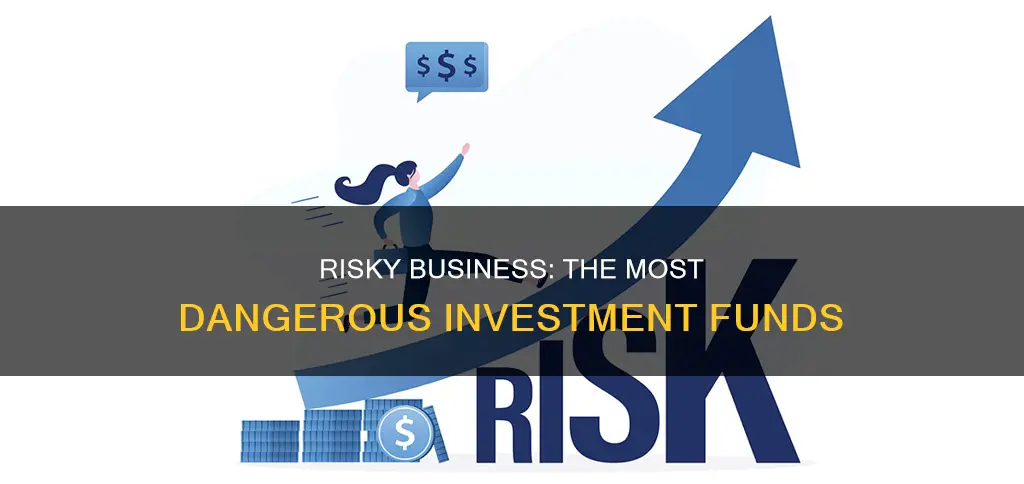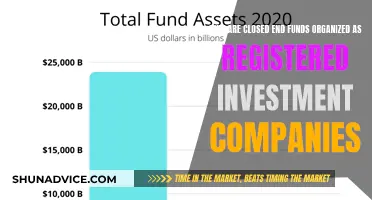
Risk is unavoidable in financial markets. While some investors seek to maximise risk for the biggest potential payoff, others prefer to minimise risk to play it safe and protect their assets. Understanding the inherent risk in any investment class and weighing it against your age, goals, and resources is crucial for making smart investment decisions.
Some of the riskiest investments include options and derivatives, oil and gas exploratory drilling, limited partnerships, penny stocks, alternative investments such as hedge funds and artwork, high-yield or junk bonds, exchange-traded funds, emerging and frontier markets, and initial public offerings (IPOs).
These investments carry a much higher degree of risk than others and can result in substantial returns or permanent losses. Investors considering these options should carefully assess their risk tolerance and conduct thorough due diligence before proceeding.
What You'll Learn

Options and derivatives
Options are financial derivatives that give buyers the right, but not the obligation, to buy or sell an underlying asset at an agreed-upon price and date. The term option refers to a financial instrument that is based on the value of underlying securities, such as stocks, indexes, and exchange-traded funds (ETFs). Each options contract will have a specific expiration date by which the holder must exercise their option. The stated price on an option is known as the strike price.
There are two types of options: call options and put options. Call options allow the holder to buy the asset at a stated price within a specific time frame. Put options, on the other hand, allow the holder to sell the asset at a stated price within a specific time frame.
Options can be used for both hedging and speculation, with strategies ranging from simple to complex. While there are many opportunities to profit with options, investors should carefully weigh the risks. Options trading can be risky, and it is best left to experienced traders as investors can quickly lose all of their principal.
Derivatives may be difficult to understand, which presents a risk in itself. They are also risky and may result in substantial losses for investors. Derivatives are impacted by market risk, counterparty risk, liquidity risk, and interconnection risk.
Mutual Funds: Investing Outside of an IRA
You may want to see also

Futures contracts
In the futures market, traders face basis, leverage, liquidity, market, and regulatory risks. Basis risk refers to the chance that the price of the futures contract doesn't move in the same way as the underlying asset. Leverage risk means that even a small, unfavourable price move against a leveraged trade can result in substantial losses. Liquidity risk refers to the difficulty of entering or exiting positions at the desired price, which is more common with less commonly traded commodities. Market risk refers to the volatility of prices, which can be swift and devastating. Finally, regulatory risk refers to the possibility that changes in regulations or tax laws can impact the market.
There are several risk management strategies that can be employed when trading futures. These include diversification, education and research, hedging, options, position sizing, regular monitoring, and using risk management tools.
Dimensional Fund Investing: A Business Strategy Overview
You may want to see also

Oil and gas drilling
The process of oil and gas drilling is extremely damaging to the environment and local communities. Drilling projects operate 24/7, generating pollution, fuelling climate change, disrupting wildlife, and damaging public lands.
Pollution and Climate Change
Oil and gas production facilities, including active wells and processing plants, scar the landscape. Over 12 million people live within a half-mile of these sites and are exposed to pollutants daily. Air pollution from fossil fuels is linked to respiratory and cardiovascular diseases and is responsible for a significant portion of deaths in people aged 14 and older in the United States. The burning of fossil fuels by automobiles, power plants, and industrial facilities further increases these emissions.
Environmental Damage
Infrastructure built for oil and gas extraction can destroy large areas of wilderness. The construction process requires heavy equipment and can leave irreversible damage. Over 12 million acres of public lands in the United States are used for fossil fuel production, impacting wildlife habitats and vegetation.
Impact on Wildlife
Oil and gas extraction disrupts wildlife habitats through noise, human movement, vehicle traffic, and the construction of power lines, well pads, fences, and roads. It also contributes to light pollution, which can disrupt the sleep, feeding, and reproductive cycles of pollinators like bees.
Additionally, oil spills can be deadly for marine life, causing long-lasting damage to marine ecosystems. Even smaller spills during the extraction process can be dangerous, as drilling fluids often leak and are splashed around drilling sites.
Safety Hazards
Oil and gas extraction also pose significant safety hazards to workers. According to the Occupational Safety and Health Administration (OSHA), highway vehicle crashes are the leading cause of worker fatalities in the industry. Other hazards include explosions and fires, high-pressure lines and equipment, electrical and other hazardous energy sources, and ergonomic risks from lifting heavy items and repetitive tasks.
A Guide to Investing in Traditional Index Funds
You may want to see also

Limited partnerships
A limited partnership is a business owned by two or more parties, including at least one general partner who runs the business and has unlimited liability for any debts, and one or more limited partners, who have liability only up to the amount of their investment.
The general partner has full management control and unlimited financial liability for their obligations. Limited partners have little to no involvement in management and are only liable up to the amount of their investment in the LP.
The main advantage of a limited partnership is the protection it offers to limited partners from personal financial liability beyond their investment. General partners, on the other hand, take on greater risk to raise capital for their investments.
There are several downsides to limited partnerships. Firstly, general partners have unlimited personal liability. Secondly, limited partners are barred from making management decisions, which can be difficult for those who want a more active role. Additionally, limited partnerships can be challenging to transfer ownership of, and there is less flexibility for changing management roles.
Due to the high risk of limited partnership investments, many brokerage firms refuse to sell them to their clients. It is crucial to exercise caution and conduct thorough due diligence before investing in limited partnerships.
Pharma Fund Investment: Should You Continue?
You may want to see also

Penny stocks
While it is possible to make money with penny stocks, it is crucial to approach them with caution and conduct thorough research.
Short-Term Bond Funds: A Safe Investment Haven
You may want to see also
Frequently asked questions
Some examples of risky investment funds include options, futures, oil and gas exploratory drilling, limited partnerships, and penny stocks.
The risks associated with these investment funds can vary but may include the loss of principal, unpredictable price changes, high volatility, and the potential for substantial losses.
Risky investment funds are typically more suitable for experienced and knowledgeable traders who understand the risks involved and are seeking high returns. Novice investors should proceed with caution.
Lower-risk investment options include savings accounts, certificates of deposit (CDs), treasury bills, notes, and bonds, money market accounts, and high-yield savings accounts.
Investors can mitigate risks by conducting thorough research, seeking diversification, and consulting with financial advisors to determine the appropriate level of risk based on their goals, risk tolerance, and time horizon.







